Abstract
The phototrophic green bacterium Chloroflexus aurantiacus was grown anaerobically in batch culture with different amino acids at 56°C and constant illumination of 25 klx. The composition of the photosynthetic apparatus was measured by quantitation of the bacteriochlorophylls (Bchl) a and c (representing the membrane-bound and the chlorosomal moieties, respectively). Ser added at concentrations up to 15 mM stimulated protein formation and Bchl a and c syntheses. A comparable stimulation was found with Glu and Ala. Coproporphyrin accumulation approached saturation at 5 mM of Ala, Asp, Orn, and Ser, while with Glu and Arg saturating concentrations were above 5 mM. Protein and tetrapyrrole syntheses became saturated at 2.5 to 5 mM of Asp, Ile, and Val. However, with Arg and Orn Bchl c synthesis was stimulated up to 2.5 mM, growth and Bchl a synthesis up to 5 mM. At higher Arg or Orn concentrations these activities were inhibited. Coproporphyrin accumulation was highest with Arg or Orn, at concentrations which inhibited growth and Bchl formation. Stimulation of Bchl synthesis took place preferentially at the level of Bchl c, while Bchl a was more sensitive toward inhibition. In both cases however, the ratio of Bchl c to Bchl a increased with higher amino acid concentrations. Nevertheless, each amino acid induced a typical effect. To understand different effects exerted by different amino acids, chemostat cultures were grown limited by either Ser or Glu. With Ser, steady state protein levels and specific Bchl a contents decreased slightly when increasing the dilution rate (D). Concomitantly Bchl c and coproporphyrin levels as well as the ratio of Bchl a/Bchl c increased. With Glu as the limiting substrate, all of the above mentioned parameters decreased. Since all of the Ser was consumed and increasing amounts of Glu remained unutilized in the spent medium, it is concluded that differences in the formation of the three pyrrole derivatives tested are due to differences in the affinities of uptake systems for Ser and Glu.
Similar content being viewed by others
References
Avissar YJ, Ormerod JG, Beale SI (1989) Distribution of 5-aminolevulinic acid biosynthetic pathways among phototrophic bacterial groups. Arch Microbiol 151: 513–519
Brenner M, Niederwieser A, Pataki G (1967) Aminosäuren und Derivate. In: Stahl E (ed) Dünnschicht-Chromatographie. Springer, Berlin Heidelberg New York, pp 696–749
Castenholz RW (1969) Thermophilic blue-green algae and the thermal environment. Bacteriol Rev 33: 476–504
Clayton RK (1966) Spectroscopic analyses of bacteriochlorophyll in vitro and in vivo. Photochem Photobiol 5: 669–677
Feick RG, Fitzpatrick M, Fuller RC (1982) Isolation and characterization of cytoplasmic membrane and chlorosomes from the green bacterium Chloroflexus aurantiacus. J Bacteriol 150: 905–915
Fuller RC, Redlinger TE (1985) Light and oxygen regulation of the development of the photosynthetic apparatus in Chloroflexus aurantiacus. In: Steinbeck KE, Bonitz S, Arntzen CL, Bogorad L (eds) Molecular biology of the photosynthetic apparatus. Cold Spring Harbor Laboratory, Cold Spring Harbor New York, pp 155–162
Hauser-Gerspach I, Oelze J (1985) Control of the syntheses of bacteriochlorophyll, c- and b-type cytochromes, and coproporphyrin III in Rhodopseudomonas sphaeroides mutant H5. Arch Microbiol 141: 151–155
Heda GD, Madigan MT (1986) Utilization of amino acids and lack of diazotrophy in the thermophilic anoxygenic phototroph Chloroflexus aurantiacus. J Gen Microbiol 132: 2469–2473
Kern M, Klemme J-H (1989) Inhibition of bacteriochlorophyll biosynthesis by gabaculin (3-amino, 2,3-dihydrobenzoic acid) and presence of an enzyme of the C5-pathway of 5-aminolevulinate synthesis in Chloroflexus aurantiacus. Z Naturforsch 44: 77–80
Lascelles J (1978) Regulation of pyrrole synthesis. In: Clayton RK, Sistrom WR (eds) The photosynthetic bacteria. Plenum Press, New York London, pp 795–808
Lessie TG, Sistrom WR (1964) Control of porphyrin synthesis in Rhodopseudomonas sphaeroides. Biochim Biophys Acta 86: 250–259
Lowry OH, Rosebrough NJ, Farr AL, Randall RF (1951) Protein measurement with the Folin phenol reagent. J Biol Chem 193: 254–275
Madigan TM, Petersen SR, Brock TD (1974) Nutritional studies on Chloroflexus, a filamentous photosynthetic, gliding bacterium. Arch Microbiol 100: 97–103
Oelze J (1983) Control of the formation of bacteriochlorophyll, and B 875- and B 850-bacteriochlorophyll complexes in Rhodopseudomonas sphaeroides mutant strain H5. Arch Microbiol 136: 312–316
Oelze J, Fuller RC (1987) Growth rate and control of the development of the photosynthetic apparatus in Chloroflexus aurantiacus. Arch Microbiol 148: 132–136
Oelze J, Jürgens UW, Ventura S (1991) Amino acid consumption by Chloroflexus aurantiacus in batch and continuous culture. Arch Microbiol 156: 226–269
Pierson BK, Castenholz RW (1974) Studies of pigments and growth in Chloroflexus aurantiacus, a phototrophic filamentous bacterium, Arch Microbiol 100: 283–305
Pipes WO, Koutsoyannis SP (1962) Light-limited growth of Chlorella in continuous culture. Appl Microbiol 10: 1–5
Author information
Authors and Affiliations
Rights and permissions
About this article
Cite this article
Oelze, J., Söntgerath, B. Differentiation of the photosynthetic apparatus of Chloroflexus aurantiacus depending on growth with different amino acids. Arch. Microbiol. 157, 141–147 (1992). https://doi.org/10.1007/BF00245282
Received:
Accepted:
Published:
Issue Date:
DOI: https://doi.org/10.1007/BF00245282




